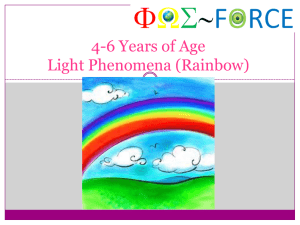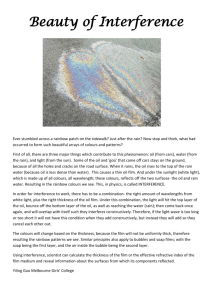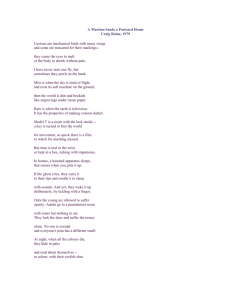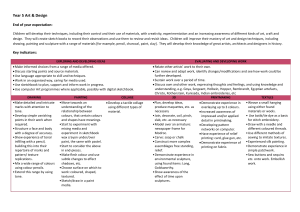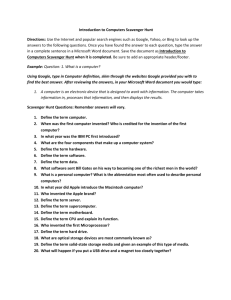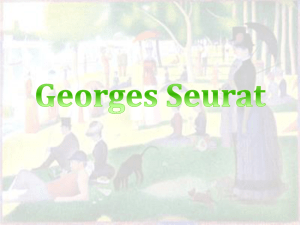Nature Activities for Nursery Groups
advertisement
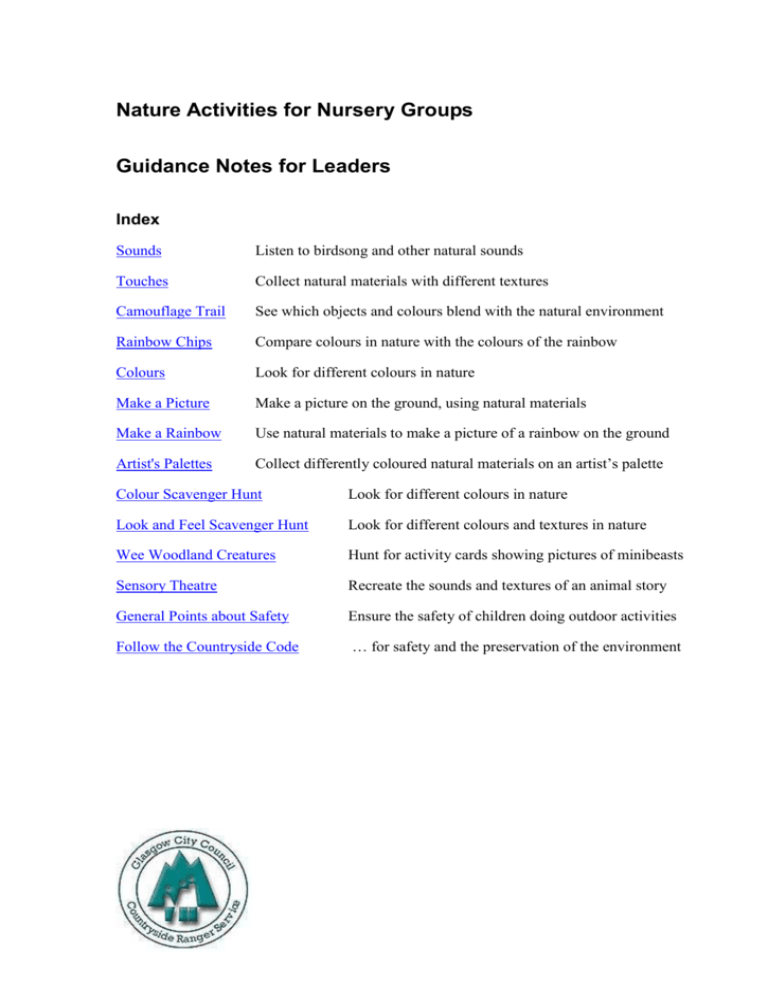
Nature Activities for Nursery Groups Guidance Notes for Leaders Index Sounds Listen to birdsong and other natural sounds Touches Collect natural materials with different textures Camouflage Trail See which objects and colours blend with the natural environment Rainbow Chips Compare colours in nature with the colours of the rainbow Colours Look for different colours in nature Make a Picture Make a picture on the ground, using natural materials Make a Rainbow Use natural materials to make a picture of a rainbow on the ground Artist's Palettes Collect differently coloured natural materials on an artist’s palette Colour Scavenger Hunt Look for different colours in nature Look and Feel Scavenger Hunt Look for different colours and textures in nature Wee Woodland Creatures Hunt for activity cards showing pictures of minibeasts Sensory Theatre Recreate the sounds and textures of an animal story General Points about Safety Ensure the safety of children doing outdoor activities Follow the Countryside Code … for safety and the preservation of the environment Sounds Location a quiet outdoor area. Instructions The children sit or lie down with their eyes closed and raise both fists in the air. Every time a child hears a new birdsong, he or she raises one finger. Count how many songs the children can hear. There are several possible variations on this activity, for example: see if you can count to 10 without the children hearing a birdsong. get the children to listen for other natural sounds, such as wind, falling leaves, etc. Notes The children must be quiet during this activity! Touches Location outdoors. Materials empty cardboard egg boxes brightly coloured paints varnish pen and paper glue. Instructions Paint some egg boxes, making them bright and cheerful, and write the word ‘touches’ on top of the lids. A coat of varnish will make the boxes more durable. Think of some contrasting textures, such as: - wet/dry - prickly/tickly - fluffy/jagged - hard/soft - rough/smooth Write each word on a slip of paper. Attach a pair of words to the bottom of each egg box. Divide the children into groups of three or four. Give each group an egg box. Tell the children that it is not actually a box for keeping eggs in, but that it is a box for collecting touches. On the bottom of each egg box are two words, which describe ‘contrasting touches’ (i.e., textures which are opposite to one another). Tell each group what their two touches are. They must not tell anyone else. Ask the children to collect three of each touch. For example, if their words were ‘hard’ and ‘soft’, they would have to collect three hard things and three soft things and put them in their boxes. The cartons are then passed around and the other children have to feel the objects and guess what the words are. The object is not to get the right answer, but simply to practise feeling different textures. Camouflage Trail Location outside, along a path in a park or woodland. Materials 10 objects or scraps of material in various colours. Instructions Choose a section of footpath and place your objects and/or scraps of material at intervals on either side of it. Do not tell the children how many objects there are. Ask the children to walk along the path one at a time and count how many objects/scraps of material they can spot. They should not pick them up. At the end, get the children to whisper to you how many they spotted. If no-one saw all of them, tell everyone how many were seen and explain that there are still more to find. Let them try again. Tell the children how many objects/scraps of material there were. End with a discussion about how camouflage helps animals and possibly go on a search for camouflaged minibeasts, etc. Notes When you are selecting materials to hide, choose some that are brightly coloured and others that will blend into the environment. Rainbow Chips Location outdoor area, preferably woodland. Materials card of different colours, e.g. paint sample cards a colourful drawstring bag. Instructions Collect some card, making sure that this includes lots of different colours: you could use paint sample cards. Cut the card into small ‘rainbow chip’ pieces. Find a colourful drawstring bag in which to store the rainbow chips: this will make the chips seem more exciting when you present them to the children. Ask the children if they have ever seen a rainbow. Talk about how rainbows have lots of different colours in them. Then explain that nature is a bit like a rainbow – it is full of different colours. Give each child several rainbow chips and ask them to match up each one with something around them, e.g. a leaf, a stone, etc. Notes This works particularly well as an autumn activity in woodlands, or during the summer in an area where there are lots of wild flowers. You could follow this activity with the Make a Rainbow activity. Colours Location outdoor area. Instructions To get children to concentrate on any natural setting, ask them how many different colours and shades of colours they can see in front of them without moving from where they are standing. Notes This could be followed by the activity Rainbow Chips or by a Colour Scavenger Hunt. Make a Picture Location outdoor area, preferably woodland. Instructions Decide on the piece of natural art that you want to make. It could be a tree, a flower, a pond or an animal. Get the children to collect leaves, twigs, grasses and other items to make up the picture on the ground. Notes This activity could be followed by making up a story about the picture. For example, if the picture show an animal, the children could act out what it does. Remember: it is illegal to pick or uproot wild flowers. Make a Rainbow Location any outdoor area. Instructions Ask the children to find different colours to make a rainbow on the ground, using natural materials like leaves, grasses, stones and berries. Notes This could be used as a follow-on from the Rainbow Chips activity. Artist’s Palette Location outdoors. Materials pen and paper card scissors double-sided sticky tape. Instructions Draw the outline of a leaf, or any other suitable shape from nature, on plain paper. This will form the artist’s palette. Copy as many of the shapes as you need onto card and cut them out. Attach a strip of double-sided sticky tape along the length of each shape, leaving the protective plastic on until you are outdoors with your group. Give each child an artist’s palette. Ask the children to collect as many colours and textures as they can and stick them onto the palette. In the end, it should bear some resemblance to a real artist’s palette. Note This activity can be followed up by talking about different colours and textures in nature. Colour Scavenger Hunt Location outdoors. Materials coloured card plain card glue. Instructions Create a Colour Scavenger Hunt sheet by pasting four or five squares of coloured card onto a piece of plain card. Each colour will show a colour from nature. Tell the children about colours in nature and encourage them to look around for the colours on the Scavenger Hunt Sheet. Look and Feel Scavenger Hunt Location outdoors. Materials print the Look and Feel Scavenger Hunt sheet supplied, or create your own. Instructions Explain to the children that there are different textures and colours in nature. Then encourage the children to look around them for those shown on the Scavenger Hunt sheet. Look and Feel Scavenger Hunt Find something jagged Find something tickly Find something smooth Find something rough Find something wet Find something dry Find something flat Find something round Wee Woodland Creatures Location area of woodland or scrub. Materials card coloured pencils or pens. Instructions Create Wee Woodland Creatures cards by drawing minibeasts that the children are likely to find. On the back of each minibeast picture, write instructions for a related activity. For example: - a drawing of a caterpillar might be accompanied by instructions on doing a leaf rubbing (because this minibeast eats leaves), or could ask the children to look for things that are long (like a caterpillar) - a drawing of a snail could relate to an activity that asks the children to find hard things in the environment, or one that requires them to look for evidence of animals’ homes. Place the cards along the length of a trail, hiding them so that the children can find them relatively easily. Take the group for a ramble along the trail and get them to look for the cards. When a card is found, ask the children what each creature is and encourage them to carry out the activity on the back of the card. Notes This activity could be followed by a minibeast hunt. Get the children to look under small logs or stones to see what creatures they can find. Sensory Theatre Location outdoors. Materials one or two large blankets, held up like stage curtains. Instructions The children are told that the curtain is no ordinary curtain: it is really a secret way into the world of wildlife. As the children and the leaders go through the curtain, they turn into different creatures. One leader, the storyteller, is on the other side of the curtain already and welcomes them to the world of wildlife. The children are addressed as though they are animals. The children are then split into two groups: - Group 1 is told a story about a duck family (using Story Sheet 1) - Group 2 is told a story about a hedgehog (using Story Sheet 2). The stories concentrate on sensory detail. After the stories have been told, the children (with help) collect the natural materials they need to recreate the sounds and textures of the story (i.e. the underlined words). For example, they may collect dry leaves to make a rustling sound or ferns for a tickly texture. When the materials have all been collected, the children in Group 1 sit down with their eyes closed. The leader from Group 2 then reads out Group 2’s story and the children from that group are encouraged to act out the story using their materials (rustling leaves, etc). When the story is finished, the groups reverse roles and Group 2 listens to Group 1’s story in the same fashion. At the end of the storytelling, the children are led back through the curtain and become human again. Ask the children to talk about what they experienced. Story Sheet 1 A Day in the Life of a Duck Family We woke up this morning in our nice soft and cosy nest under Mummy’s wing. We were all huddled and cuddled together. Time to go off for a swim. Off we quacked to the pond. The grass was tickling our tummies and feet. We squelched through the mud and splashed into the cold wet pond. We said, ‘Good morning’ to Mr Frog, who said, ‘Ribbet’ back. Then he flopped into the water beside us. A dragonfly zoomed past and we felt a breeze on out faces. Then the dragonfly landed on a lily. The dragonfly was really brightly coloured and its wings made funny buzzing noises. We went to investigate and smelled the sweet smell of the flower. Our tummies started to rumble. Time to eat! Mummy showed us how to duck down and get pondweed. We ate until we were full. We were all very tired by now and it was fun crunching through the dry leaves and twigs on the way back to our safe, soft nest. We all went to sleep. ZZZZZZZZZZZZZZZZ Z Story Sheet 2 A Day in the Life of Hamish the Hedgehog Hamish usually wakes up at dusk. He sleeps during the day under a pile of rustling leaves or fallen branches. When it’s dark, Hamish sets off to find his food. Walking through the long grass, which tickles his feet, he uses his nose to snuffle out the smell of slugs, his favourite food. Even though they are slimy, Hamish crunches them up in one mouthful. Suddenly he hears the call of the owl, ‘Twit-twoo’, and feels the rush of air overhead as it flies off to catch a nearby mouse. Hamish knows the owl has caught it as he hears a squeak! Hamish continues snuffling about, making a lot of rustling and scraping noises. As he forces his way through a scratchy hedge he feels the twigs brush against his spines. Just before dawn, Hamish comes to a road. He can hear the zoom of a passing car. He crosses it, feeling the hard surface beneath his feet. Heading home, Hamish feels very tired. He walks through the tickly wet grass of a field and finally gets back to his warm dry pile of leaves. He curls up, fast asleep, and stays warm and dry all day. General Points about Safety Here are some general guidelines followed by the Countryside Ranger Service to ensure the safety of children during outdoor activities. Run through the following questions as you plan the children’s activities. Know your group… How many children are there? Do any of them have special needs or medical conditions that you should be prepared for? Know the area you are going to… Is the area safe for the activity, free of broken glass, away from roads etc? Where is the nearest phone? Where is the nearest A&E department? Be prepared… Have you got a first aid kit? Do you have emergency contact numbers for the children’s parents/guardians? Do the children have suitable clothing/footwear? Are they going to be able to stay warm and dry if the weather changes? Are there enough adults to supervise the children? Make the children aware that some plants sting, have thorns or may be poisonous. Make sure that the children always wash their hands after an activity. Follow the Countryside Code Guard against all risk of fire. Fasten all gates. Keep dogs under control. Keep to public paths across farmland. Use gates and stiles to cross fences, hedges and walls. Help to keep all water clean. Leave animals, crops and machinery alone. Take your litter home. Protect all forms of wildlife, including plants. Take special care on narrow country roads. Glasgow City Council Countryside Ranger Service promotes responsible use of the countryside. For more information, contact the Countryside Rangers at: Countryside Ranger Service Old Stable Courtyard Pollok Country Park 2060 Pollokshaws Road Glasgow G43 1AT Tel: 0141 632 9299

